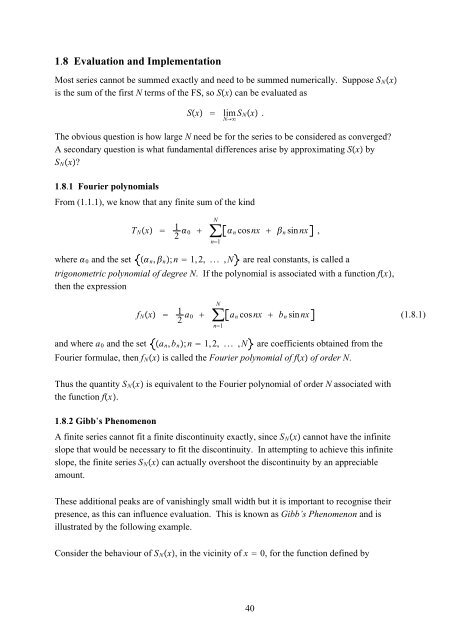Fourier Series
Fourier Series
Fourier Series
Create successful ePaper yourself
Turn your PDF publications into a flip-book with our unique Google optimized e-Paper software.
1.8 Evaluation and ImplementationMost series cannot be summed exactly and need to be summed numerically. Suppose S N xis the sum of the first N terms of the FS, so Sx can be evaluated asSx limN→S N x .The obvious question is how large N need be for the series to be considered as converged?A secondary question is what fundamental differences arise by approximating Sx byS N x?1.8.1 <strong>Fourier</strong> polynomialsFrom (1.1.1), we know that any finite sum of the kindT N x 1 N2 0 ∑n1 n cosnx n sinnx ,where 0 and the set n , n ;n 1,2, ... ,N are real constants, is called atrigonometric polynomial of degree N. If the polynomial is associated with a function fx,then the expressionf N x 1 N2 a 0 ∑n1a n cosnx b n sinnx (1.8.1)and where a 0 and the set a n ,b n ;n 1,2, ... ,N are coefficients obtained from the<strong>Fourier</strong> formulae, then f N x is called the <strong>Fourier</strong> polynomial of fx of order N.Thus the quantity S N x is equivalent to the <strong>Fourier</strong> polynomial of order N associated withthe function fx.1.8.2 Gibb’s PhenomenonA finite series cannot fit a finite discontinuity exactly, since S N x cannot have the infiniteslope that would be necessary to fit the discontinuity. In attempting to achieve this infiniteslope, the finite series S N x can actually overshoot the discontinuity by an appreciableamount.These additional peaks are of vanishingly small width but it is important to recognise theirpresence, as this can influence evaluation. This is known as Gibb’s Phenomenon and isillustrated by the following example.Consider the behaviour of S N x, in the vicinity of x 0, for the function defined by40
















